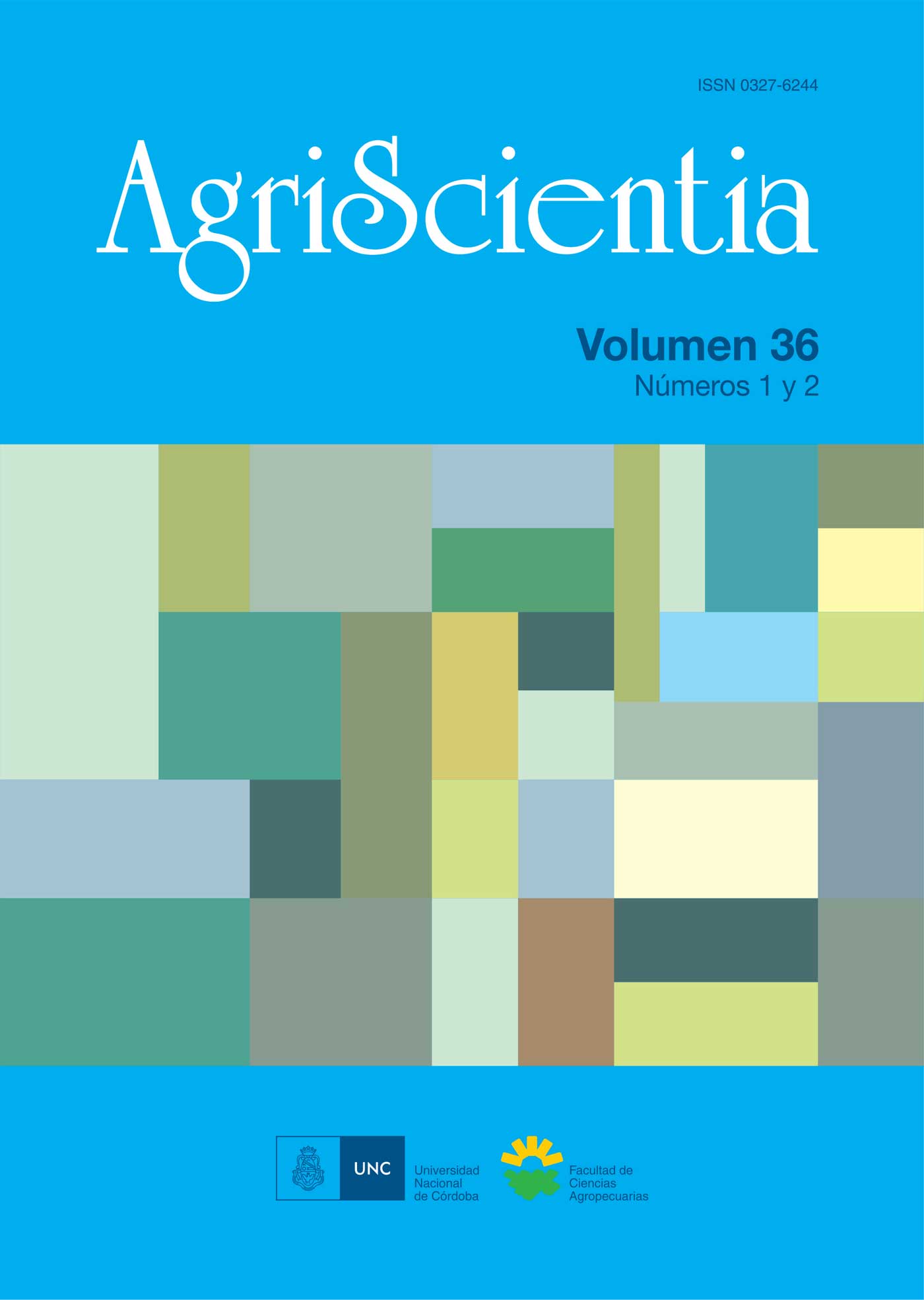Adjustment of the technical specifications for the Tetrazolium viability test in Cenchrus ciliaris L. (buffel grass) seeds
Main Article Content
Abstract
The objective of the study was to establish guidelines for the viability test of seeds by tetrazolium in Cenchrus ciliaris using the Panicum protocols (ISTA, 2012). We worked with fascicles (dispersion unit) of Cenchrus ciliaris of the Texas cultivar from which caryopses were extracted to perform the tests. The appropriate method for cutting caryopses and the staining times were determined and two concentrations of tetrazolium solution were tested. In addition, after adjusting the conditions, evaluation protocols were developed. The adequate conditions to perform the viability test are 18 h of seed wetting between papers at a temperature of 20 °C, incomplete longitudinal cut through the embryo, tetrazolium concentration at 0.5 or 1 % and 10 hours of staining at 30 °C. The staining maps allow differentiating accurately the viability of the caryopses.
Article Details
How to Cite
References
Agüero C. G., Pereyra G. y R. O. Rolando (2017). Método alternativo de germinación para determinar la calidad de semillas en Buffel Grass (Cenchrus ciliaris L.). Agriscientia, 34 (1) 47-58. doi: 10.31047/1668.298x.v34.n1.17465
Association of Official Seed Analysts (AOSA) (2009). Seed Vigor Testing Handbook. Ithaca, NY, USA: Association of Official Seed Analysts.
Ayerza R. (1981). El Buffel Grass: utilidad y manejo de una promisoria gramínea.Buenos Aires, Argentina: Editorial Hemisferio Sur.
Bulat, H. (1961). Reduction processes in living tissue, formazan, tetrazolium salts and their importance as reduction-oxidation indicators in resting seed. En Proceedings of the International Seed Testing Association, 26 (686-696). Copenhagen, Denmark: International Seed Testing Association.
Copeland T.G., Bruce C.F. and Jr. J.W Midyette. (1959). The unofficial application of tetrazolium test as an aid in checking germination claims. Proceedings of the Association of Official Seed Analyst (AOSA), 49 (134-141). East Lansing, Michigan, U.S.A.
Delouche J. C., Still T. W, Raspet M. and Lienhard M. (1962). The tetrazolium test for seed viability (Technical Bulletin 51). Mississippi, EEUU: Mississipi State University.
Di Rienzo J. A., Casanoves F., Balzarini M.G., Gonzalez, Tablada M. y Robledo C.W. InfoStat versión 2015. Grupo InfoStat, FCA, Universidad Nacional de Córdoba, Argentina. Recuperado de: http://www.infostat.com.ar
Ellis R. H., Hong T. D. and Roberts E. H. (1985). Handbook of seed technology for gene banks (3), Vol. II Compendium of specific germination information and test recommendations. Rome, Italy: International Board for Plant Genetic Resources (IBPGR). Recuperado de: https://www.bioversityinternational.org/index.php?id=244&tx_news_pi1%5Bnews%5D=147&tx_news_pi1%5Bcontroller%5D=News&tx_news_pi1%5Baction%5D=detail&cHash=d6db487481db43bfff382748e6f24bc9
Gosling P.G. (2003). Viability testing. In: Smith R.D., Dickie J.B., Lenintong S.H., Pritchard H.W., Probert R.J. (Eds),Seed Conservation: Turning Science into Practice (445-481). Kew, U.K.: Royal Botanic Gardens.
International Seed Testing Association [ISTA] (2003). International Rules for Seed Testing. Working Sheets on Tetrazolium Testing. Zürich, Bassersdorf,Switzzerland: ISTA.
International Seed Testing Association [ISTA] (2012). International Rules for Seed Testing. Seed Science and Technology 31. Zürich, Switzzerland: ISTA.
Krzyzanowski, F.C., Vieira R. D., Franca Neto J. B. (1999). Testes de Tetrazólio para Determinaçãodo Vigor de Sementes. Vigor de Sementes: Conceitos e Testes. Londrina, PR, Brasil: Abrates.
Moore R. P. (1973). Tetrazolium staining for assessing seed quality. En: Heydecker, W. (Ed.) Seed Ecology(347-366). London, England: Butterworth.
Moore R. P. (1985). Manual de ensayos al tetrazolio. Madrid, España: Instituto Nacional de Semillas y Plantas de Vivero.
Pérez H. (2005). Características de las especies forrajeras adaptadas a las condiciones del Noroeste del país. (Documento no publicado). Hotel Holiday Inn, Córdoba, Argentina.
Peske S.T., Rosenthal M. D. y Madeiros Rota G. R. (Eds.). (2003). Sementes: Fundamentos científicos e tecnológicos. Pelotas, Brasil: Rua.
Reartes D. (2003). El futuro de la ganadería argentina. Recuperado de: http://www.produccion-animal.com.ar/informacion_tecnica/origenes_evolucion_y_estadisticas_de_la_ganaderia/17-futuro_ganaderia_argentina.pdf
Sharif-Zadeh F. and Murdoch A. J. (2000). The effects of different maturation conditions on seed dormancy and germination of Cenchrus ciliaris. Seed Science Research, 10 (4), 447-457. doi:10.1017/S0960258500000490
Smith F.G. (1952). The mechanism of the tetrazolium reaction in corn embryos. Plant Physiology, 27(3), 445-456.doi:10.1104/pp.27.3.445
Smith F.G. y Throneberry G.O. (1951). The tetrazolium test and seed viability. Proccedings of the Association of Official Seed Analysts, 41, 105-109.





